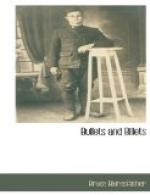OUR MOATED FARM—WULVERGHEM—THE
CURE’S HOUSE—A SHATTERED CHURCH
—MORE “HEAVIES”—A
FARM ON FIRE
Our farm was one of a cluster of three or four, each approximately a couple of hundred yards apart. It was perhaps the largest and the most preserved of the lot. It was just the same sort of shape as all Flemish farms—a long building running round three sides of the yard, in the middle of which there was an oblong tank, used for collecting all the rubbish and drainage.
The only difference about our farm was, we had a moat. Very superior to all the cluster in consequence. Sometime or other the moat must have been very effective; but when I was there, only about a quarter of it contained water. The other three-quarters was a sort of bog, or marsh, its surface broken up by large shell holes. On the driest part of this I discovered a row of graves, their rough crosses all battered and bent down. I just managed to discern the names inscribed; they were all French. Names of former heroes who had participated in some action or other months before. Going out into the fields behind the farm, I found more French graves, enclosed in a rectangular graveyard that had been roughly made with barbed wire and posts, each grave surmounted with the dead soldier’s hat. Months of rough wintry weather had beaten down the faded cloth cap into the clay mound, and had started the obliteration of the lettering on the cross. A few more months; and cross, mound and hat will all have merged back into the fields of Flanders.
Beyond these fields, about half a mile distant, lay Wulverghem. Looking at what you can see of this village from the Douve farm, it looks exceedingly pretty and attractive. A splendid old church tower could be seen between the trees, and round about it were clustered the red roofs of a fair-sized village. It has, to my mind, a very nice situation. In the days before the war it must have been a pleasing place to live in. I went to have a look at it one day. It’s about as fine a sample of what these Prussians have brought upon Belgian villages as any I have seen. The village street is one long ruin. On either side of the road, all the houses are merely a collection of broken tiles and shattered bricks and framework. Huge shell holes punctuate the street. I had seen a good many mutilated villages before this, but I remember thinking this was as bad, if not worse, than any I had yet seen. I determined to explore some of the houses and the church.
I went into one house opposite the church. It had been quite a nice house once, containing about ten rooms. It was full of all sorts of things. The evacuation had evidently been hurried. I went into the front right-hand room first, and soon discovered by the books and pictures that this had been the Cure’s house. It was in a terrible state. Religious books in French and Latin lay about the floor in a vast disorder, some with the cover and half the book torn off by the effect of an explosion. Pictures illustrating Bible scenes, images, and other probably cherished objects, smashed and ruined, hung about the walls, or fragmentary portions of them lay littered about on the floor.




